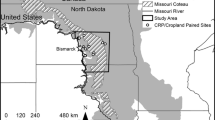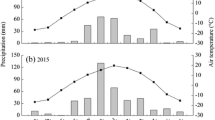Abstract
Long-term soil carbon (C) storage is essential for reducing CO2 in the atmosphere. Converting unproductive and environmentally sensitive agricultural lands to grasslands for bioenergy production may enhance C storage. However, a better understanding of the interacting effects of grass functional composition (i.e., relative abundance of C4 and C3 grass cover) and soil productivity on C storage will help guide sustainable grassland management. Our objective was to examine the relationship between grass functional composition and potential C storage and how it varies with potential soil productivity. We estimated C inputs from above- and belowground net primary productivity (ANPP and BNPP), and heterotrophic respiration (R H) to calculate net ecosystem production (NEP), a measure of potential soil C storage, in grassland plots of relatively high- and low-productivity soils spanning a gradient in the ratio of C4 to C3 grass cover (C4:C3). NEP increased with increasing C4:C3, but only in potentially productive soils. The positive relationship likely stemmed from increased ANPP, rather than BNPP, which was possibly related to efficient resource-use and physiological/anatomical advantages of C4 plants. R H was negatively correlated with C4:C3, possibly because of changes in microclimate or plant–microbe interactions. It is possible that in potentially productive soils, C storage can be enhanced by favoring C4 over C3 grasses through increased ANPP and BNPP and reduced R H. Results also suggest that potential C storage gains from C4 productivity would not be undermined by a corresponding increase in R H.




Similar content being viewed by others
References
Angelo CL, Pau S (2015) Root biomass and soil δ13C in C3 and C4 grasslands along a precipitation gradient. Plant Ecol 216:615–627. https://doi.org/10.1007/s11258-015-0463-y
Arbuckle JL (2014) Amos (Version 24.0). IBM SPSS, Chicago
Atkinson RRL, Mockford EJ, Bennett C, Christin P-A, Spriggs EL, Freckleton RP, Thompson K, Rees M, Osborne CP (2016) C4 photosynthesis boosts growth by altering physiology, allocation and size. Nat Plants 2:1–5. https://doi.org/10.1038/nplants.2016.38
Barney JN, Mann JJ, Kyser GB et al (2009) Tolerance of switchgrass to extreme soil moisture stress: ecological implications. Plant Sci 177:724–732. https://doi.org/10.1016/j.plantsci.2009.09.003
Barton K (2016) MuMIn: multi-model inference. R package version 1.15.6. https://CRAN.R-project.org/package=MuMIn
Bond-Lamberty BP, Thomson AM (2014) A global database of soil respiration data, Version 3.0. Oak Ridge National Laboratory Distributed Active Archive Center. http://daac.ornl.gov
Bray RH, Kurtz LT (1945) Determination of total, organic, and available forms of phosphorus in soils. Soil Sci 59:39–46
Brye KR, Gower ST, Norman JM, Bundy LG (2002) Carbon budgets for a prairie and agroecosystems: effects of land use and interannual variability. Ecol Appl 12:962–979. https://doi.org/10.1890/1051-0761(2002)012[0962:CBFAPA]2.0.CO;2
Burnham KP, Anderson DR (2002) Model selection and multimodel inference: a practical information-theoretic approach. Springer, New York
Cahill KN, Kucharik CJ, Foley JA (2009) Prairie restoration and carbon sequestration: difficulties quantifying C sources and sinks using a biometric approach. Ecol Appl 19:2185–2201. https://doi.org/10.1890/08-0069.1
Carney KM, Hungate BA, Drake BG, Megonigal JP (2007) Altered soil microbial community at elevated CO2 leads to loss of soil carbon. Proc Natl Acad Sci 104:4990–4995. https://doi.org/10.1073/pnas.0610045104
Carpenter SR, Caraco NF, Correll DL et al (1998) Nonpoint pollution of surface waters with phosphorus and nitrogen. Ecol Appl 8:559–568. https://doi.org/10.1890/1051-0761(1998)008[0559:NPOSWW]2.0.CO;2
Chou WW, Silver WL, Jackson RD et al (2008) The sensitivity of annual grassland carbon cycling to the quantity and timing of rainfall. Glob Change Biol 14:1382–1394. https://doi.org/10.1111/j.1365-2486.2008.01572.x
Collatz GJ, Berry JA, Clark JS (1998) Effects of climate and atmospheric CO2 partial pressure on the global distribution of C4 grasses: present, past, and future. Oecologia 114:441–454. https://doi.org/10.1007/s004420050468
Dybzinski R, Farrior CE, Pacala SW (2015) Increased forest carbon storage with increased atmospheric CO2 despite nitrogen limitation: a game-theoretic allocation model for trees in competition for nitrogen and light. Glob Change Biol 21:1182–1196. https://doi.org/10.1111/gcb.12783
Elliot ET, Heil JW, Kelly EF, Monger HC (1999) Soil structural and other physical properties. In: Robertson GP, Coleman DC, Bledsoe CS, Sollins P (eds) Standard soil methods for long-term ecological research. Oxford University Press, New York, pp 74–85
Fahey TJ, Hughes JW (1994) Fine root dynamics in a northern hardwood forest ecosystem, Hubbard Brook Experimental Forest, NH. J Ecol 82:533–548. https://doi.org/10.2307/2261262
Fahey TJ, Bledsoe CS, Day FP et al (1999) Fine root production and demography. In: Standard soil methods for long-term ecological research. Oxford University Press, New York, p 437
Gelfand I, Sahajpal R, Zhang X et al (2013) Sustainable bioenergy production from marginal lands in the US Midwest. Nature 493:514–517. https://doi.org/10.1038/nature11811
Gill RA, Kelly RH, Parton WJ et al (2002) Using simple environmental variables to estimate below-ground productivity in grasslands. Glob Ecol Biogeogr 11:79–86. https://doi.org/10.1046/j.1466-822X.2001.00267.x
Heady HF, Gibbens RP, Powell RW (1959) A comparison of the charting, line intercept, and line point methods of sampling shrub types of vegetation. J Range Manag 12:180–188. https://doi.org/10.2307/3894848
Heiri O, Lotter AF, Lemcke G (2001) Loss on ignition as a method for estimating organic and carbonate content in sediments: reproducibility and comparability of results. J Paleolimnol 25:101–110. https://doi.org/10.1023/A:1008119611481
IPCC (2007) Climate change 2007: the physical science basis. In: Solomon S, Qin D, Manning M, Chen Z, Marquis M, Averyt KB, Tignor M, Miller HL (eds) Contribution of working group I to the fourth assessment. Report of the intergovernmental panel on climate change. Cambridge University Press, Cambridge, p 996
Jarchow ME, Liebman M, Rawat V, Anex RP (2012) Functional group and fertilization affect the composition and bioenergy yields of prairie plants. GCB Bioenergy 4:671–679. https://doi.org/10.1111/j.1757-1707.2012.01184.x
Jenny H (1980) The soil resource: origin and behavior. Springer, New York
Jobbágy EG, Jackson RB (2000) The vertical distribution of soil organic carbon and its relation to climate and vegetation. Ecol Appl 10:423–436. https://doi.org/10.1890/1051-0761(2000)010[0423:TVDOSO]2.0.CO;2
Kocacinar F, Sage RF (2003) Photosynthetic pathway alters xylem structure and hydraulic function in herbaceous plants. Plant Cell Environ 26:2015–2026. https://doi.org/10.1111/j.1365-2478.2003.01119.x
Kocacinar F, McKown AD, Sage TL, Sage RF (2008) Photosynthetic pathway influences xylem structure and function in Flaveria (Asteraceae). Plant Cell Environ 31:1363–1376. https://doi.org/10.1111/j.1365-3040.2008.01847.x
Kuzyakov YV, Larionova AA (2006) Contribution of rhizomicrobial and root respiration to the CO2 emission from soil (A review). Eurasian Soil Sci 39:753–764. https://doi.org/10.1134/S106422930607009X
Kuzyakov Y, Xu X (2013) Competition between roots and microorganisms for nitrogen: mechanisms and ecological relevance. New Phytol 198:656–669. https://doi.org/10.1111/nph.12235
Lal R (2003) Offsetting global CO2 emissions by restoration of degraded soils and intensification of world agriculture and forestry. Land Degrad Dev 14:309–322. https://doi.org/10.1002/ldr.562
Lal R (2004) Soil carbon sequestration impacts on global climate change and food security. Science 304:1623–1627. https://doi.org/10.1126/science.1097396
Landis DA (2017) Designing agricultural landscapes for biodiversity-based ecosystem services. Basic Appl Ecol 18:1–12. https://doi.org/10.1016/j.baae.2016.07.005
Lark TJ, Salmon JM, Gibbs HK (2015) Cropland expansion outpaces agricultural and biofuel policies in the United States. Environ Res Lett 10:044003. https://doi.org/10.1088/1748-9326/10/4/044003
Long SP (1999) Environmental responses. In: Sage RF, Monson RK (eds) C4 plant biology. Academic Press, San Diego, pp 215–249
Matamala R, Jastrow JD, Miller RM, Garten CT (2008) Temporal changes in C and N stocks of restored prairie: implications for C sequestration strategies. Ecol Appl 18:1470–1488. https://doi.org/10.1890/07-1609.1
Nie M, Pendall E, Bell C et al (2013) Positive climate feedbacks of soil microbial communities in a semi-arid grassland. Ecol Lett 16:234–241. https://doi.org/10.1111/ele.12034
NOAA (National Oceanic and Atmospheric Administration) (2017) Climate data online. https://www.ncdc.noaa.gov/cdo-web/. Accessed 9 Jan 2017
Norman JM, Garcia R, Verma SB (1992) Soil surface CO2 fluxes and the carbon budget of a grassland. J Geophys Res Atmos 97:18845–18853. https://doi.org/10.1029/92JD01348
Pinheiro J, Bates D, DebRoy S, Sarkar D, R Core Team (2017). nlme: Linear and Nonlinear Mixed Effects Models. R package version 3.1-131. https://CRAN.R-project.org/package=nlme
Powlson DS, Whitmore AP, Goulding KWT (2011) Soil carbon sequestration to mitigate climate change: a critical re-examination to identify the true and the false. Eur J Soil Sci 62:42–55. https://doi.org/10.1111/j.1365-2389.2010.01342.x
R Development Core Team (2017) R: a language and environment for statistical computing. Austria, Vienna
Raich JW, Tufekciogul A (2000) Vegetation and soil respiration: correlations and controls. Biogeochemistry 48:71–90. https://doi.org/10.1023/A:1006112000616
Randerson JT, Chapin FS, Harden JW et al (2002) Net ecosystem production: a comprehensive measure of net carbon accumulation by ecosystems. Ecol Appl 12:937–947. https://doi.org/10.1890/1051-0761(2002)012[0937:NEPACM]2.0.CO;2
Robertson GP, Coleman DC, Bledsoe CS, Sollins P (1999) Standard soil methods for long-term ecological research. Oxford University Press, New York
Robertson GP, Dale VH, Doering OC et al (2008) Sustainable biofuels redux. Science 322:49–50. https://doi.org/10.1126/science.1161525
Sage RF, Pearcy RW (1987) The nitrogen use efficiency of C3 and C4 plants. Plant Physiol 84:954–958
Sage RF, Zhu XG (2011) Exploiting the engine of C4 photosynthesis. J Exp Bot 62:2989–3000. https://doi.org/10.1093/jxb/err179
Scurlock JMO, Hall DO (1998) The global carbon sink: a grassland perspective. Glob Change Biol 4:229–233. https://doi.org/10.1046/j.1365-2486.1998.00151.x
Scurlock JMO, Johnson K, Olson RJ (2002) Estimating net primary productivity from grassland biomass dynamics measurements. Glob Change Biol 8:736–753. https://doi.org/10.1046/j.1365-2486.2002.00512.x
Sheehy JE, Ferrer AB, Mitchell PL, Elmido-Mabilangen A, Pablico P, Dionora MJA (2007) How the rice crop works and why it needs a new engine. In: Sheehy JE, Mitchell PL, Hardy B (eds) Charting new pathways to C4 rice. International Rice Research Institute, Los Banos, pp 3–26
Simonsen CEB (2004) Investigations of germination, composition, structure, and physiognomy in three Wisconsin prairie restorations. MS thesis, University of Wisconsin-Madison
Smith P (2004) Soils as carbon sinks: the global context. Soil Use Manag 20:212–218. https://doi.org/10.1111/j.1475-2743.2004.tb00361.x
Soil Survey Staff, Natural Resources Conservation Service, United States Department of Agriculture (2017) Web soil survey. https://websoilsurvey.sc.egov.usda.gov/. Accessed 09 Jan 2017
Spiesman BJ, Bennett A, Isaacs R, Gratton C (2018) Harvesting effects on bee communities in bioenergy grasslands depend on nesting guild. Ecol Appl (in press)
Taylor SH, Hulme SP, Rees M et al (2010) Ecophysiological traits in C3 and C4 grasses: a phylogenetically controlled screening experiment. New Phytol 185:780–791. https://doi.org/10.1111/j.1469-8137.2009.03102.x
Teeri JA, Stowe LG (1976) Climatic patterns and the distribution of C4 grasses in North America. Oecologia 23:1–12. https://doi.org/10.1007/BF00351210
Tilman D, Hill J, Lehman C (2006) Carbon-negative biofuels from low-input high-diversity grassland biomass. Science 314:1598–1600. https://doi.org/10.1126/science.1133306
UNFCCC (United Nations Framework Convention on Climate Change) (2015) Adoption of the Paris Agreement, 21st Conference of the Parties. United Nations, Paris
University of Wisconsin Agricultural Extension (2017) Automated Weather Observation Network. http://agwx.soils.wisc.edu/uwex_agwx/awon. Accessed 9 Jan 2017
Vitousek PM, Aber JD, Howarth RW et al (1997) Human alteration of the global nitrogen cycle: sources and consequences. Ecol Appl 7:737–750. https://doi.org/10.1890/1051-0761(1997)007[0737:HAOTGN]2.0.CO;2
Vogt KA, Grier CC, Gower ST et al (1986) Overestimation of net root production: a real or imaginary problem? Ecology 67:577–579. https://doi.org/10.2307/1938601
Von Fischer JC, Tieszen LL, Schimel DS (2008) Climate controls on C3 vs. C4 productivity in North American grasslands from carbon isotope composition of soil organic matter. Glob Change Biol 14:1141–1155. https://doi.org/10.1111/j.1365-2486.2008.01552.x
von Haden AC, Dornbush ME (2017) Ecosystem carbon pools, fluxes, and balances within mature tallgrass prairie restorations. Restor Ecol. https://doi.org/10.1111/rec.12461 (in press)
Wedin D, Tilman D (1993) Competition among grasses along a nitrogen gradient: initial conditions and mechanisms of competition. Ecol Monogr 63:199–229. https://doi.org/10.2307/2937180
Werling BP, Dickson TL, Isaacs R et al (2014) Perennial grasslands enhance biodiversity and multiple ecosystem services in bioenergy landscapes. Proc Natl Acad Sci 111:1652–1657. https://doi.org/10.1073/pnas.1309492111
White KP, Langley JA, Cahoon DR, Megonigal JP (2012) C3 and C4 biomass allocation responses to elevated CO2 and nitrogen: contrasting resource capture strategies. Estuar Coast 35:1028–1035. https://doi.org/10.1007/s12237-012-9500-4
Acknowledgements
We thank Gary Oates, Adam von Haden, and members of the Jackson lab for insightful discussions of our study. This work was funded by the DOE-Great Lakes Bioenergy Research Center (DOE Office of Science BER DE-FC02-07ER64494) and a USDA North Central Region-Sustainable Agriculture, Research & Education graduate student award to HK.
Author information
Authors and Affiliations
Contributions
HK and RDJ conceived and designed the study. HK performed the field and lab work. BJS analyzed the data. BJS wrote the manuscript with input and edits from HK and RDJ.
Corresponding author
Additional information
Communicated by Mercedes Bustamante.
Electronic supplementary material
Below is the link to the electronic supplementary material.
Rights and permissions
About this article
Cite this article
Spiesman, B.J., Kummel, H. & Jackson, R.D. Carbon storage potential increases with increasing ratio of C4 to C3 grass cover and soil productivity in restored tallgrass prairies. Oecologia 186, 565–576 (2018). https://doi.org/10.1007/s00442-017-4036-8
Received:
Accepted:
Published:
Issue Date:
DOI: https://doi.org/10.1007/s00442-017-4036-8




